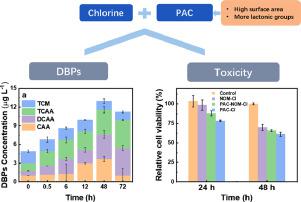Water Research ( IF 11.4 ) Pub Date : 2021-09-13 , DOI: 10.1016/j.watres.2021.117660 Xin Huang 1 , Ying Yu 2 , Huan Chen 1 , Huikai Liang 1 , Mengze Geng 1 , Baoyou Shi 2

|
With the deterioration of source water quality, pre-chlorination and pre-addition of powdered activated carbon (PAC) have been widely applied to improve water treatment efficiency, which would lead to PAC exposure to chlorine. Although previous studies reported that some emerging carbon materials (e.g., graphene) could potentially act as disinfection by-product (DBP) precursors, there were few studies paying attention to the interaction between chlorine and the most commonly used carbon material-PAC on the DBP formation. In this study, the DBPs formed by chlorination with and without PAC were investigated, and the DBP toxicities in different systems were evaluated. The results showed that the PAC could react with chlorine and form trihalomethanes (THMs) and haloacetic acids (HAAs). The amount of surface oxygen groups of the PAC increased during the chlorination, with these oxygen groups, especially the meta-positioned –OH groups, facilitating the formation of THMs and HAAs. In the presence of NOM, lower concentrations of THMs and HAAs were observed in the systems with PAC than in those without PAC, demonstrating the critical role of PAC adsorption towards DBP control. The cytotoxicity evaluation indicated that more toxic reaction products between PAC and chlorine were formed besides conventional DBPs. Moreover, the PAC with higher BET surface area and more lactonic function groups formed less toxic DBPs during chlorination, which might reduce health risk for treatment processes with pre-chlorination.
中文翻译:

活性炭加氯消毒副产物形成及毒性评价
随着源水水质的恶化,粉状活性炭(PAC)的预氯化和预添加已被广泛应用以提高水处理效率,这会导致PAC暴露于氯中。尽管之前的研究报道了一些新兴的碳材料(例如石墨烯)可能充当消毒副产物 (DBP) 的前体,但很少有研究关注氯与 DBP 上最常用的碳材料 PAC 之间的相互作用形成。在这项研究中,研究了有和没有 PAC 氯化形成的 DBP,并评估了不同系统中 DBP 的毒性。结果表明,PAC 可以与氯反应并形成三卤甲烷 (THM) 和卤代乙酸 (HAAs)。间位 -OH 基团,促进 THM 和 HAA 的形成。在 NOM 的存在下,在有 PAC 的系统中观察到的 THM 和 HAA 浓度低于没有 PAC 的系统,表明 PAC 吸附对 DBP 控制的关键作用。细胞毒性评估表明,除常规 DBP 外,PAC 与氯之间形成了更多的毒性反应产物。此外,具有更高 BET 表面积和更多内酯官能团的 PAC 在氯化过程中形成的 DBP 毒性较小,这可能会降低预氯化处理过程的健康风险。











































 京公网安备 11010802027423号
京公网安备 11010802027423号